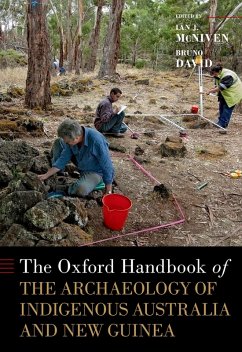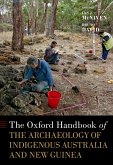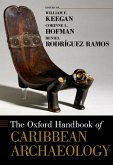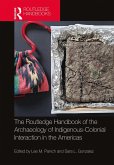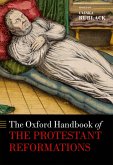The Oxford Handbook of the Archaeology of Indigenous Australia and New Guinea (eBook, PDF)
Redaktion: McNiven, Ian J.; David, Bruno


Alle Infos zum eBook verschenken

The Oxford Handbook of the Archaeology of Indigenous Australia and New Guinea (eBook, PDF)
Redaktion: McNiven, Ian J.; David, Bruno
- Format: PDF
- Merkliste
- Auf die Merkliste
- Bewerten Bewerten
- Teilen
- Produkt teilen
- Produkterinnerung
- Produkterinnerung

Hier können Sie sich einloggen

Bitte loggen Sie sich zunächst in Ihr Kundenkonto ein oder registrieren Sie sich bei bücher.de, um das eBook-Abo tolino select nutzen zu können.
65,000 years ago, modern humans arrived in Australia, having navigated more than 100 km of sea crossing from southeast Asia. Since then, the large continental islands of Australia and New Guinea, together with smaller islands in between, have been connected by land bridges and severed again as sea levels fell and rose. Along with these fluctuations came changes in the terrestrial and marine environments of both land masses. The Oxford Handbook of the Archaeology of Indigenous Australia and New Guinea reviews and assembles the latest findings and ideas on the archaeology of the Australia-New…mehr
- Geräte: PC
- mit Kopierschutz
- eBook Hilfe
- Größe: 97.68MB
![The Oxford Handbook of the Archaeology of Indigenous Australia and New Guinea (eBook, ePUB) The Oxford Handbook of the Archaeology of Indigenous Australia and New Guinea (eBook, ePUB)]() The Oxford Handbook of the Archaeology of Indigenous Australia and New Guinea (eBook, ePUB)112,95 €
The Oxford Handbook of the Archaeology of Indigenous Australia and New Guinea (eBook, ePUB)112,95 €![The Oxford Handbook of Caribbean Archaeology (eBook, PDF) The Oxford Handbook of Caribbean Archaeology (eBook, PDF)]() The Oxford Handbook of Caribbean Archaeology (eBook, PDF)114,95 €
The Oxford Handbook of Caribbean Archaeology (eBook, PDF)114,95 €![Tracing Early Agriculture in the Highlands of New Guinea (eBook, PDF) Tracing Early Agriculture in the Highlands of New Guinea (eBook, PDF)]() Tim DenhamTracing Early Agriculture in the Highlands of New Guinea (eBook, PDF)40,95 €
Tim DenhamTracing Early Agriculture in the Highlands of New Guinea (eBook, PDF)40,95 €![Routledge Handbook of the Archaeology of Indigenous-Colonial Interaction in the Americas (eBook, PDF) Routledge Handbook of the Archaeology of Indigenous-Colonial Interaction in the Americas (eBook, PDF)]() Routledge Handbook of the Archaeology of Indigenous-Colonial Interaction in the Americas (eBook, PDF)40,95 €
Routledge Handbook of the Archaeology of Indigenous-Colonial Interaction in the Americas (eBook, PDF)40,95 €![The Routledge Handbook of the History of Settler Colonialism (eBook, PDF) The Routledge Handbook of the History of Settler Colonialism (eBook, PDF)]() The Routledge Handbook of the History of Settler Colonialism (eBook, PDF)44,95 €
The Routledge Handbook of the History of Settler Colonialism (eBook, PDF)44,95 €![The Oxford Handbook of the European Bronze Age (eBook, PDF) The Oxford Handbook of the European Bronze Age (eBook, PDF)]() The Oxford Handbook of the European Bronze Age (eBook, PDF)27,95 €
The Oxford Handbook of the European Bronze Age (eBook, PDF)27,95 €![The Oxford Handbook of the Protestant Reformations (eBook, PDF) The Oxford Handbook of the Protestant Reformations (eBook, PDF)]() The Oxford Handbook of the Protestant Reformations (eBook, PDF)29,95 €
The Oxford Handbook of the Protestant Reformations (eBook, PDF)29,95 €-
-
-
Dieser Download kann aus rechtlichen Gründen nur mit Rechnungsadresse in A, B, BG, CY, CZ, D, DK, EW, E, FIN, F, GR, HR, H, IRL, I, LT, L, LR, M, NL, PL, P, R, S, SLO, SK ausgeliefert werden.
- Produktdetails
- Verlag: Oxford University Press
- Seitenzahl: 1136
- Erscheinungstermin: 5. Dezember 2023
- Englisch
- ISBN-13: 9780190095635
- Artikelnr.: 69496559
- Verlag: Oxford University Press
- Seitenzahl: 1136
- Erscheinungstermin: 5. Dezember 2023
- Englisch
- ISBN-13: 9780190095635
- Artikelnr.: 69496559
* The Thick Darkness of Pre-Historic Time: Antiquarian Archaeology in
Nineteenth-Century Colonial Victoria by Ian J. McNiven
* History of Archaeology in Papua New Guinea: The Early Years Up to
1960 by Glenn R. Summerhayes
* Trans-Disciplinary Approaches to the Past in New Guinea by Chris
Ballard
* Oral Tradition, History, and Archaeohistory of Indigenous Australia
by Iain Davidson, Heather Burke, Lynley A. Wallis, Pearl Connelly,
Lance Sullivan, Hazel Sullivan, Stephen Porter, and Isabel Tarragó
* Cultural Heritage and Contract Archaeology in Australia and New
Guinea by Joanna Fresløv
* Museum Collections and their Legacies by Lindy Allen
* Island Hopping to Sahul by Kasih Norman, Sue O'Connor, and Michael
Bird
* Australia's First People: Oldest Sites and Early Culture by Chris
Clarkson, Kasih Norman, Sue O'Connor, Jane Balme, Peter Veth, and
Ceri Shipton
* Interactions with Megafauna by Chris N. Johnson, Joe Dortch, and
Trevor H. Worthy
* What Does DNA Tell Us about Past Connections and the Settlement of
Sahul? by Elizabeth Matisoo-Smith and Anna L. Gosling
* Fire and the Transformation of Landscapes by Cassandra Rowe, Janelle
Stevenson, Simon Connor, and Matthew Adeleye
* Beyond Agriculture: Ditch Networks in the New Guinea Landscape by
Chris Ballard
* Enhanced Ecologies and Ecosystem Engineering: Strategies Developed by
Aboriginal Australians to Increase the Abundance of Animal Resources
by Ian J. McNiven, Tiina Manne, and Anne Ross
* The Coming of the Dingo by Jane Balme and Sue O'Connor
* Engaging and Designing Place: Furnishings and the Architecture of
Archaeological Sites in Aboriginal Australia by Bruno David,
Jean-Jacques Delannoy, Chris Urwin, Joanna Fresløv, Russell Mullett,
and Christine Phillips
* The Big Flood: Responding to Sea-Level Rise and the Inundated
Continental Shelf by Jonathan Benjamin and Sean Ulm
* Past Aboriginal Populations and Demographic Change Using Radiocarbon
Data and Time-Series Analysis by Alan Williams, Sean Ulm, and M. A.
Smith
* Persistence of Complexity: Continuation of Intensification,
Population Change, and Socio-Structural Change in Current Debates in
Australian Archaeology by Harry Lourandos and Anne Ross
* Boundaries, Relationality, and Style Provinces in Australian Rock Art
by Madeleine Kelly and Liam M. Brady
* Australian Indigenous Ochres: Use, Sourcing, and Exchange by Jillian
Huntley
* Axe Quarrying, Production, and Exchange in Australia and New Guinea
by Anne Ford and Peter Hiscock
* Shell Valuables and Exchange Systems in New Guinea by Kat Szabó
* Language Evolution and Spread by Patrick McConvell and Nick Evans
* Stone Tool Manufacture and Use by Chris Clarkson
* Mortars and Pestles Make the Mid-Holocene Occupation of New Guinea
and the Bismarck Archipelago Visible by Pamela Swadling
* Pottery Exchange Systems in New Guinea by Glenn R. Summerhayes
* Coral Sea Cultural Interaction Sphere by Ian J. McNiven
* Maritime Coastal and Island Societies of Australia and New Guinea by
Michael Rowland, Ben Shaw, and Sean Ulm
* Below the Sky, Above the Clouds: The Archaeology of the Australian
High Country by Joanna Fresløv and Russell Mullett
* The Archaeology of Social Transformation in the New Guinea Highlands
by Dylan Gaffney and Tim Denham
* Beyond the Barriers: A New Model for the Settlement of Australian
Deserts by Peter Veth, Jo McDonald, and Peter Hiscock
* Murray River Societies in Australia through the Lens of
Bioarchaeology by Judith Littleton, Sarah Karstens, and Harry Allen
* Swamp and Delta Societies of the Papuan Gulf, Papua New Guinea by
Chris Urwin, James W. Rhoads, and Joshua A. Bell
* Historisizing the "Dreaming": An Archaeological Perspective from Arid
Australia by M. A. Smith
* Dugongs and Turtles as Kin: Relational Ontologies and Archaeological
Perspectives on Ritualized Hunting by Coastal Indigenous Australians
by Ian J. McNiven
* Rock Art Modification and its Ritualized and Relational Contexts by
Liam M. Brady, R. G. Gunn, and Joakim Goldhahn
* Asian Traders and Macassan Trepangers by Daryl Wesley
* Whaling and Sealing in Nineteenth-Century Australia by Martin Gibbs
and Lynette Russell
* Fatal Frontier: Temporal and Spatial Considerations of the Native
Mounted Police and Colonial Violence Across Queensland by Lynley A.
Wallis, Heather Burke, Bryce Barker, and Noelene Cole
* Missions and Reserves by Jeremy Ash
* The Archaeology of Agrarian Australia by Alistair Paterson
* Contact Rock Art by Jo McDonald, Ursula K. Frederick
* The Development (and Imagined Reinvention) of Australian Archaeology
in the Twentieth Century by Chris Urwin and Matthew Spriggs
* Approaching Indigenous Archaeologies in Australia by Christopher
Wilson
* Earth Mounding in the Western District of Victoria by Julian Dunn
* Flaked Stone Tools of Holocene Sahul: Case studies from Northern
Australia and Papua New Guinea by Tim Ryan Maloney
* Plant Exploitation and Long-Term Cultural Change in Sahul: The
Archaeobotanical Perspective by Stephanie Florin and Andrew Fairbairn
* Stone-Walled Fish Traps of Australia and New Guinea as Expressions of
Enhanced Sociality by Ian J. McNiven and Ariana B. J. Lambrides
* The Thick Darkness of Pre-Historic Time: Antiquarian Archaeology in
Nineteenth-Century Colonial Victoria by Ian J. McNiven
* History of Archaeology in Papua New Guinea: The Early Years Up to
1960 by Glenn R. Summerhayes
* Trans-Disciplinary Approaches to the Past in New Guinea by Chris
Ballard
* Oral Tradition, History, and Archaeohistory of Indigenous Australia
by Iain Davidson, Heather Burke, Lynley A. Wallis, Pearl Connelly,
Lance Sullivan, Hazel Sullivan, Stephen Porter, and Isabel Tarragó
* Cultural Heritage and Contract Archaeology in Australia and New
Guinea by Joanna Fresløv
* Museum Collections and their Legacies by Lindy Allen
* Island Hopping to Sahul by Kasih Norman, Sue O'Connor, and Michael
Bird
* Australia's First People: Oldest Sites and Early Culture by Chris
Clarkson, Kasih Norman, Sue O'Connor, Jane Balme, Peter Veth, and
Ceri Shipton
* Interactions with Megafauna by Chris N. Johnson, Joe Dortch, and
Trevor H. Worthy
* What Does DNA Tell Us about Past Connections and the Settlement of
Sahul? by Elizabeth Matisoo-Smith and Anna L. Gosling
* Fire and the Transformation of Landscapes by Cassandra Rowe, Janelle
Stevenson, Simon Connor, and Matthew Adeleye
* Beyond Agriculture: Ditch Networks in the New Guinea Landscape by
Chris Ballard
* Enhanced Ecologies and Ecosystem Engineering: Strategies Developed by
Aboriginal Australians to Increase the Abundance of Animal Resources
by Ian J. McNiven, Tiina Manne, and Anne Ross
* The Coming of the Dingo by Jane Balme and Sue O'Connor
* Engaging and Designing Place: Furnishings and the Architecture of
Archaeological Sites in Aboriginal Australia by Bruno David,
Jean-Jacques Delannoy, Chris Urwin, Joanna Fresløv, Russell Mullett,
and Christine Phillips
* The Big Flood: Responding to Sea-Level Rise and the Inundated
Continental Shelf by Jonathan Benjamin and Sean Ulm
* Past Aboriginal Populations and Demographic Change Using Radiocarbon
Data and Time-Series Analysis by Alan Williams, Sean Ulm, and M. A.
Smith
* Persistence of Complexity: Continuation of Intensification,
Population Change, and Socio-Structural Change in Current Debates in
Australian Archaeology by Harry Lourandos and Anne Ross
* Boundaries, Relationality, and Style Provinces in Australian Rock Art
by Madeleine Kelly and Liam M. Brady
* Australian Indigenous Ochres: Use, Sourcing, and Exchange by Jillian
Huntley
* Axe Quarrying, Production, and Exchange in Australia and New Guinea
by Anne Ford and Peter Hiscock
* Shell Valuables and Exchange Systems in New Guinea by Kat Szabó
* Language Evolution and Spread by Patrick McConvell and Nick Evans
* Stone Tool Manufacture and Use by Chris Clarkson
* Mortars and Pestles Make the Mid-Holocene Occupation of New Guinea
and the Bismarck Archipelago Visible by Pamela Swadling
* Pottery Exchange Systems in New Guinea by Glenn R. Summerhayes
* Coral Sea Cultural Interaction Sphere by Ian J. McNiven
* Maritime Coastal and Island Societies of Australia and New Guinea by
Michael Rowland, Ben Shaw, and Sean Ulm
* Below the Sky, Above the Clouds: The Archaeology of the Australian
High Country by Joanna Fresløv and Russell Mullett
* The Archaeology of Social Transformation in the New Guinea Highlands
by Dylan Gaffney and Tim Denham
* Beyond the Barriers: A New Model for the Settlement of Australian
Deserts by Peter Veth, Jo McDonald, and Peter Hiscock
* Murray River Societies in Australia through the Lens of
Bioarchaeology by Judith Littleton, Sarah Karstens, and Harry Allen
* Swamp and Delta Societies of the Papuan Gulf, Papua New Guinea by
Chris Urwin, James W. Rhoads, and Joshua A. Bell
* Historisizing the "Dreaming": An Archaeological Perspective from Arid
Australia by M. A. Smith
* Dugongs and Turtles as Kin: Relational Ontologies and Archaeological
Perspectives on Ritualized Hunting by Coastal Indigenous Australians
by Ian J. McNiven
* Rock Art Modification and its Ritualized and Relational Contexts by
Liam M. Brady, R. G. Gunn, and Joakim Goldhahn
* Asian Traders and Macassan Trepangers by Daryl Wesley
* Whaling and Sealing in Nineteenth-Century Australia by Martin Gibbs
and Lynette Russell
* Fatal Frontier: Temporal and Spatial Considerations of the Native
Mounted Police and Colonial Violence Across Queensland by Lynley A.
Wallis, Heather Burke, Bryce Barker, and Noelene Cole
* Missions and Reserves by Jeremy Ash
* The Archaeology of Agrarian Australia by Alistair Paterson
* Contact Rock Art by Jo McDonald, Ursula K. Frederick
* The Development (and Imagined Reinvention) of Australian Archaeology
in the Twentieth Century by Chris Urwin and Matthew Spriggs
* Approaching Indigenous Archaeologies in Australia by Christopher
Wilson
* Earth Mounding in the Western District of Victoria by Julian Dunn
* Flaked Stone Tools of Holocene Sahul: Case studies from Northern
Australia and Papua New Guinea by Tim Ryan Maloney
* Plant Exploitation and Long-Term Cultural Change in Sahul: The
Archaeobotanical Perspective by Stephanie Florin and Andrew Fairbairn
* Stone-Walled Fish Traps of Australia and New Guinea as Expressions of
Enhanced Sociality by Ian J. McNiven and Ariana B. J. Lambrides
